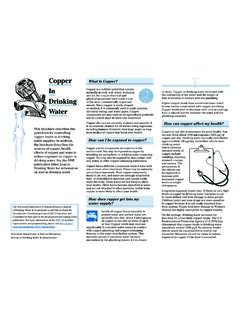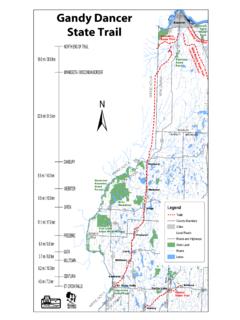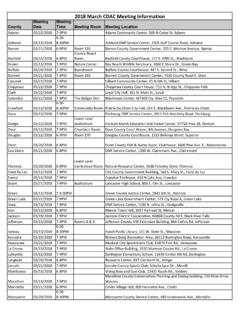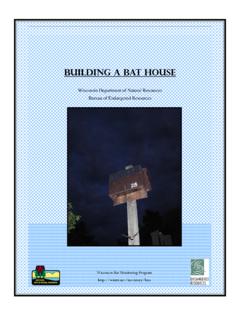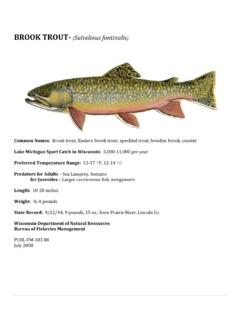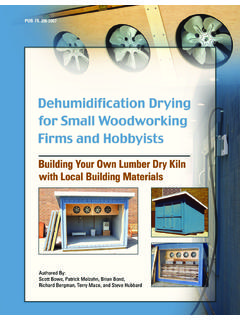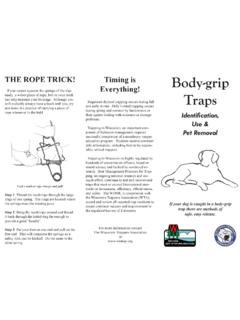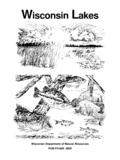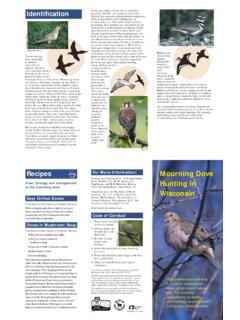Transcription of Wisconsin Trapping - Wisconsin Department of Natural …
1 2020. Wisconsin Trapping Regulations Photo: Bryan Pater, Waupun The Wisconsin Department of Natural Resources will shift to a bag limit/quota for the 2020-21 river otter Trapping season. This change is intended to simplify regulations while maintaining safeguards that ensure the river otter population remains abundant. Two otter harvest authorizations per Trapping license will be issued for the 2020-21 season and can be used in either the Northern and/or the Southern otter zone. Physical registration with a conservation warden or other authorized DNR staff is still a mandatory requirement. Trappers must report their otter by phone or online within 24 hours of harvest. Youths Trapping without a license will need to add the otter authorizations at (see page 26). Report Natural Resource Violations CALL or TEXT: 800-TIP-WDNR. (800-847-9367). Toll Free Statewide 24-Hour Confidential PUB-WM-002-2020.
2 This pamphlet gives you a summary of Wisconsin 's Trapping laws and how they affect you. For complete Trapping and hunting laws, consult the Wisconsin State Statutes Chapter 29 or Chapter 10 of the Administrative Code of the Department of Natural Resources. Table of Contents What's New in .3..4. Special Rules Clarification ..5. License and Permit .6. Mississippi River .8. Use of Trail Cameras on Department -Managed .8. Trapping .8. Trap Checking .9. Trap Size and Placement .9..10. Body-Grip Trap ..11. Cable Restraint ..12. Foot-Activated Cable ..13. Colony ..14. Possession ..14. Special Regulations: Bobcat, Fisher and ..15. Game Management .16. Trapping on DNR-managed .17. Registration and Carcass Collection for ..18. Marten Restoration ..19. Seasons and Bag Limits ..20. Fisher and 22. Coyote, Raccoon, Red and Gray ..23. Mink and Carcass Data .25. Trapping in State.
3 25. Youth Supervised and Mentored 26. Best Management Practices for Trapping Furbearers in the .. 27. Boat 28. Trapper Education 28. Contact the 32. 2. Dear Trappers and Hunters, Wisconsin continues to be a leader. Our commitment to trapper education and regulated Trapping is demonstrated annually by over 200 Wisconsin Trappers Association instructors who donate countless hours of their lives to teach new students what it means to be a trapper in Wisconsin . Their dedication is vital to ensuring all new trappers have the education and tools necessary to make good decisions while afield. Wisconsin 's leadership is also demonstrated by the Department 's continual collaboration with partner groups and the public in reviewing our regulations for new opportunities and ways to improve Trapping in the state. New in 2020, there will be no application period for river otter because they will now be managed on a bag limit/quota system.
4 Two otter harvest authorizations per Trapping license will be issued for the 2020-21 season and can be used in either the Northern or Southern otter zone. The key point to remember is that each harvest authorization permits the take of one otter, just like with a tag. The Department will monitor harvest and can close the season if the quota has been met. There are a couple of additional changes for 2020 to note. Find them below under What's New in 2020.. Thank you once again for your interest, support, and commitment to regulated Trapping in Wisconsin . Prior to, during and after the Trapping season, act as if the future of Trapping depends on your actions because it does! Have a safe, productive and memorable season. Shawn Rossler Furbearer Specialist What's New in 2020. Otter drawing: The otter drawing has been eliminated for the 2020 Trapping season.
5 Two otter harvest authorizations per Trapping license will be issued for the 2020-21 season and can be used in either the Northern or Southern otter zone. Trapping on beaver dams: Trapping within 15 feet of beaver dams is now legal. This change allows the placement of traps, snares, colony traps or cable restraints within 15 feet of a beaver dam found on either private or public land. Operating a trap which permits a trapped animal to reach water remains illegal unless the mink, beaver, otter or muskrat season is open in the zone you are Trapping (or you are using an enclosed trigger trap). Incidental take of raccoons: Incidental raccoon caught in beaver sets after the close of the raccoon season can now be retained by the trapper. This change creates the same exemption for raccoon as muskrat. Marten protection area changes: Foothold traps (with no less than 4 lbs.)
6 Of pan tension). and weasel boxes (with no opening larger than 1 3/8 inch in diameter, and anchored to an immovable object) are now legal to use within the two existing Marten Protection Areas. The new rule also creates a 3rd Marten Protection Area within the Apostle Islands National Lakeshore, an area where a new population of American marten were recently found. Footholds and weasel boxes are not allowed within this newly created Marten Protection Area. 3. Definitions Body-Grip Trap: a steel trap designed to allow the animal's head, neck or torso to enter the trap opening and be held by compression of the jaws when sprung. Definitions Cable Restraint: a cable noose used for restraining furbearing animals which does not allow the device or trapped animal to reach unfrozen water. Cage or Box Trap: a trap that is designed to allow an animal to enter the trap enclosure, be captured and remain alive inside the cage or box-type enclosure until it can be released unharmed or reduced to possession by the operator of the trap.
7 This trap may not be used as a water set or with any other type of trap. Capable of Submersing: a set designed to allow the trapped animal to travel to water of sufficient depth to cause irreversible complete submersion. Colony Trap: an enclosure-type device that allows for the capture of one or more furbearing animals in a single setting as a submersion set. See size and placement restrictions on page 14. Enclosed Trigger Trap: any trap with a push or pull-activated trigger located inside an enclosure and recessed 1 inches or more from an opening that is no greater than 1 . inches in diameter. The diameter of the opening is measured as the straight line distance across the opening between the two inside points which are furthest apart. If the opening is square or rectangular, this measurement must be made from the two opposite corners that are furthest apart.
8 Foot-Activated Cable Restraint: a passive or spring-activated cable noose used for restraining furbearing animals by the foot which does not allow the device or trapped animal to reach unfrozen water. Furbearing Animal: for the purpose of this pamphlet means bobcat, fisher, otter, coyote, raccoon, red fox, gray fox, mink, muskrat, beaver, skunk, weasel, woodchuck and opossum. Jawed Trap: a trap designed to catch an animal by the foot, but does not include enclosed trigger traps, cable restraints or body-gripping traps. Non-Submersion Set: any trap set that is capable of capturing an animal and not capable of submersing the captured animal. Sight Exposed Bait: any bait which can be seen from above. Snare: a wire noose used for restraining furbearing animals in a water set. Water Set: a trap or snare which is set or staked in a manner to permit the trap, snare or trapped animal to reach unfrozen water.
9 Animals Protected at All Times The following wild animals are designated protected and have no open season: wolf, badger, Canada lynx, cougar, flying squirrel, moose, American marten, white or albino deer, wolverine and any other species designated protected, endangered or threatened. Warden Authority Conservation wardens performing their duties may enter private lands at any time. Wardens may also seize as evidence all game taken or possessed in violation of the law and any equipment used in connection with a violation. Wardens do not have the authority to enforce trespass laws. 4. Bobcat Research and Harvest DNR researchers have been investigating bobcat populations since 2014. In cooperation with trappers, we have learned a lot about bobcats in Wisconsin and continue to refine Special Rules population estimates and models as new information becomes available through these research efforts.
10 There are several bobcats with GPS tracking collars around two study areas: one focused on the Northwoods and the other focused on the driftless area. If you encounter a bobcat with a collar, please treat it as it if didn't have a collar. These animals are legal for take if you possess a bobcat permit valid for that zone and season. Special Rule Clarifications Preseason Marking of Trap Sites: using stakes or other devices to mark a trap site anywhere prior to the season opener is not allowed on DNR-managed lands and is not recommended on other public lands. It does not legally reserve the site for the person placing the stake or markers. Trapping on Managed Forest Law (MFL) and Forest Crop Law (FCL) lands: With permission of the landowner/property manager, Trapping is allowed on lands enrolled under the Forest Crop Law program and lands designated as open under the Managed Forest Law program.
